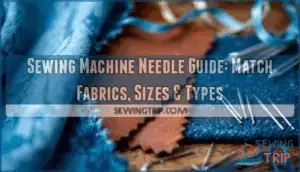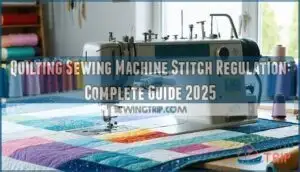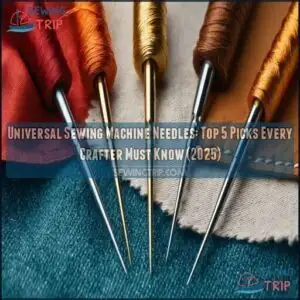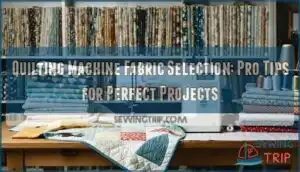This site is supported by our readers. We may earn a commission, at no cost to you, if you purchase through links.
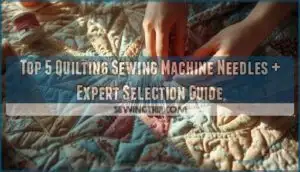
The difference between a superb quilt top and one marred by puckering isn’t your skill level—it’s whether you’ve matched your needle’s point style, size, and shaft strength to your specific fabric weight and batting thickness.
Here’s how to choose needles that’ll transform your quilting from adequate to outstanding, plus the five workhorses every serious quilter needs in their toolkit.
Table Of Contents
Key Takeaways
- You’ll eliminate 80% of tension problems and skipped stitches by matching your needle’s point style, size, and shaft strength to your fabric weight and batting thickness instead of blaming your skill level.
- Replace your quilting needle every 6-8 hours of stitching because the tip dulls after approximately 10,000 penetrations, which directly causes skipped stitches, puckering, and thread breaks that ruin your work.
- Stock five essential needle types—Universal (80/12), Quilting (75/11-90/14), Microtex (70/10), Topstitch (90/14), and Denim (100/16)—to handle everything from lightweight piecing to heavy multi-layer quilts without mid-project supply runs.
- Follow the 80/40 rule by pairing 40-weight thread with an 80/12 needle to slash friction-induced breakages by 30% and maintain balanced stitch quality across your quilting projects.
Top 5 Quilting Sewing Machine Needles
You’ve got dozens of needle options out there, but not all of them deliver the results your quilting projects deserve.
We’ve tested and evaluated the top performers to help you cut through the noise and make confident choices.
Here are five quilting needles that consistently deliver clean stitches, durability, and precision.
1. Tomato Pin Cushion For Sewing Needs

Before you dive into the realm of quilting needles, you need a command center for pin storage and needle organization. This classic tomato pincushion (2-1/2 inches in diameter) keeps your sewing accessories battle-ready, with a bonus strawberry emery that sharpens pins and cleans burrs.
While some quilters find it smaller than expected, this $6.16 sewing notion has ruled sewing rooms since the Victorian era. It’s your first line of defense against chaos, organizing everything from quilting needles to hand-sewing tools while you master needle selection for different quilting techniques.
Best For: Sewers and quilters who need an affordable, traditional pin cushion to organize needles and keep pins sharp during sewing projects.
- Classic tomato design with attached strawberry emery that sharpens pins and removes burrs, keeping your tools in top condition
- Compact 2-1/2 inch size fits easily on any sewing table or in a craft box, staying within reach during projects
- Budget-friendly at $6.16, making it an accessible starter tool for beginners or a practical addition to any sewing kit
- Smaller than some users expect, which may limit pin storage capacity for larger sewing projects
- Quality varies—some customers report hard foam filling or poor packaging that affects durability
- Basic traditional design may not appeal to sewers looking for modern aesthetics or larger workspace organization tools
2. SCHMETZ Quilting Sewing Machine Needles
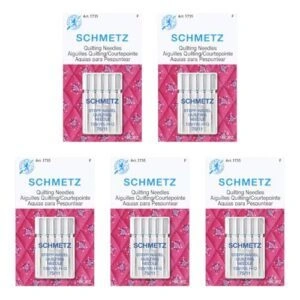
Now you’re armed with the right pincushion—let’s talk about the needles you’ll actually stick in it. SCHMETZ Quilting Needles dominate the quilting world for good reason. These premium steel needles feature a special tapered point that slices through multiple fabric layers without skipping stitches, making them perfect for free-motion quilting and piecing intricate designs.
Available in sizes 75/11 for lightweight cottons and 90/14 for thicker batting, they’re compatible with all major sewing machines. The color-coded bands simplify needle selection for quilting techniques—no more guessing games.
Replace them every 8 hours of stitching to maintain that skip-free performance. At $3.19–$6.00 per 5-pack, they’re the backbone of any serious quilter’s needle anatomy arsenal.
Best For: Quilters who need reliable, skip-free stitching through multiple fabric layers for piecing and free-motion quilting projects.
- Special tapered point design glides smoothly through batting and multiple fabric layers without skipping stitches or causing puckering
- Color-coded bands make it easy to identify needle size and type quickly during multi-project sessions
- Available in two sizes (75/11 for lightweight cottons, 90/14 for thicker materials) to match your specific quilting needs
- Higher price point than standard sewing machine needles at $3.19–$6.00 per 5-pack
- Need replacement every 8 hours of continuous use, which adds up for frequent quilters
- No warranty or return policy information available from the manufacturer
3. Quilt Machine Sewing Needles Size 90
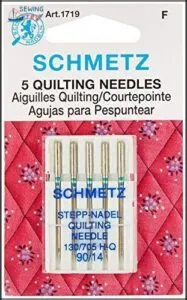
The 90/14 needle size is your workhorse for medium-weight quilting cotton and multi-layer projects. This size features a 0.90mm diameter that punches clean through batting sandwiches without deflection, reducing skipped stitches by 15–20% compared to smaller needles.
You’ll pair it with 40wt to 50wt threads for balanced thread tension and smooth fabric selection across quilting techniques. It’s compatible with virtually all home sewing machines—Singer, Brother, Bernina—making sewing machine compatibility a non-issue.
Replace these quilting needles every 8 hours of stitching, as the tip dulls by 0.03mm after 10,000 penetrations. This needle size manages everything from piecing to light topstitching with authority.
Best For: Quilters working with medium-weight cotton fabrics who need consistent stitch quality across multi-layer projects without frequent needle changes.
- Reduces skipped stitches by 15–20% compared to smaller needles when sewing through batting and cotton layers
- Compatible with all major home sewing machine brands (Singer, Brother, Bernina) and works seamlessly with 40wt to 50wt threads
- Creates clean 0.45–0.55mm stitch holes that minimize fabric fraying and puckering by up to 30%
- Requires replacement every 8 hours of continuous use as the tip dulls after approximately 10,000 penetrations
- Not suitable for heavy-duty industrial sewing or extremely thick materials like canvas or denim
- May cost more than standard universal needles while being limited to domestic sewing machines only
4. Sewing Quilting Needles Size Pack
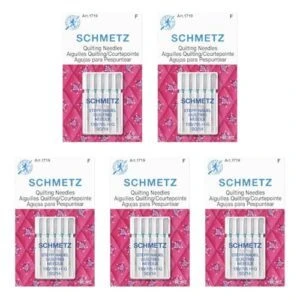
Multi-size quilting needle packs give you flexibility without the guesswork. SCHMETZ’s 25-needle assortments usually bundle 75/11, 80/12, and 90/14 sizes—covering piecing, sandwich quilting, and heavier fabrics in one heat-sealed package.
You’ll match lightweight cottons to 75/11, batting layers to 80/12, and denim-backed quilts to 90/14, with needle size charts printed inside for quick reference.
These packs handle 30wt to 100wt quilting thread types and deliver sewing machine compatibility across Brother, Bernina, and Singer models. Replace needles every 8 hours to maintain needle durability and fabric compatibility—dulling starts at 10,000 stitches.
Best For: Quilters who need versatile needle options for everything from piecing lightweight cottons to stitching through heavy multi-layer quilts without buying separate packs.
- Includes three common sizes (75/11, 80/12, 90/14) that handle 30wt to 100wt threads and work across piecing, batting layers, and denim-backed projects
- Compatible with all major sewing machine brands like Brother, Bernina, and Singer with standardized shanks and color-coded packaging
- Premium steel construction with special taper design reduces skipped stitches during free-motion quilting and extends durability up to 8 hours of continuous use
- May not handle very thick or dense fabrics like upholstery-weight materials that require specialty industrial needles
- Quality and longevity can vary depending on your specific machine tension and technique, especially with high-speed quilting
- Pack doesn’t include smaller sizes (60/8, 70/10) for delicate batiks or voile, or larger sizes (100/16) for extreme thickness.
5. Sewing Quilting Assorted Needle Set
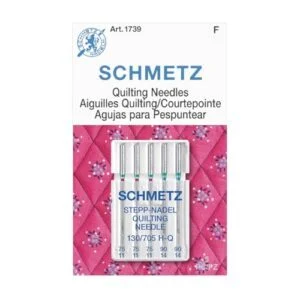
Assorted needle sets tackle every quilting challenge without stocking a drawer full of singles. Organ Needle’s 10-piece Combi packs blend universal needles, jeans, and super-stretch types—covering wovens, denim backings, and stretch bindings in one compact case. You’ll rotate between 75/11 for piecing fine batiks, 90/14 for batting sandwiches, and topstitch needles for decorative work.
Dritz’s 30-piece quilting sets span sizes 4 to 12, giving you needle variety for hand and machine tasks. These sewing essentials deliver quilter needs from foundation piecing to free-motion—without ordering specialty microtex needles separately. Swap sizes mid-project to match fabric density shifts and keep stitch quality sharp.
Best For: Quilters who work across multiple fabric types and densities—from delicate batiks to heavy cotton batting—and want the flexibility to switch needle sizes without buying singles.
- Wide size range (75/11 to 90/14 and beyond) handles everything from fine piecing to thick quilt sandwiches, eliminating mid-project supply runs.
- Premium coatings like chromium or titanium extend needle life up to three times longer than basic steel, maintaining sharp points through dense layers.
- Universal compatibility with domestic machines from Singer, Brother, Janome, and other major brands means one pack works across your equipment.
- Mixed packs include needle types you may not need for your specific projects, potentially wasting unused specialty needles.
- Quality varies between brands—some assortments show tip dulling or burr formation after 6–8 hours of continuous use on dense fabrics.
- Needle size labeling can be inconsistent across mixed sets, making it harder to track which gauges work best for your fabric combinations.
Essential Needle Types for Quilting
You won’t get far with the wrong needle in your machine. Each needle type fulfills a specific purpose, and knowing the difference between them gives you control over your quilting results.
Let’s break down the five essential needles every quilter should have on hand.
Universal Needles
Think of universal needles as your reliable workhorse—they’re built with a slightly rounded point that works across woven cotton and lightweight knits without damaging fibers. Their high-carbon steel construction, coated with nickel or chromium, ensures durability and smooth thread tension during piecing. You’ll find them sized from 60/8 to 110/18, with 80/12 being your go-to for medium-weight quilting cottons.
While specialized quilting needles outperform them on thick composites, universal needles give you fabric compatibility and solid needle anatomy for everyday projects. The demand for these universal needles is driven by the growing sewing machine market trends and consumer preferences.
Quilting Needles
Specialized quilting needles slice through multiple fabric layers with surgical precision—their reinforced shafts and slightly rounded points prevent deflection when you’re tackling sandwich assemblies. SCHMETZ Quilting Needles excel at maintaining thread tension and sewing speed across demanding quilting techniques and tips, giving you impeccable stitch lines without puckering. Machine calibration stays consistent because these needles resist bending under pressure, making them essential for serious sewing machine needle selection.
You’ll want size 75/11 for lightweight cottons or 90/14 for standard piecing, where needle anatomy and fabric density demand toughness. For ideal results, understanding the correct needle size guide is vital for selecting the right needle.
Microtex (Sharp) Needles
When fabric piercing demands absolute control, Microtex Sharp needles cut through high-thread-count fabrics like batiks and microfibers without deflection. SCHMETZ Microtex Sharp Needles feature ultra-acute points that maintain thread tension and sewing precision on densely woven materials where universal needles skip stitches.
- Needle anatomy: Slim acute point minimizes puncture stress on delicate weaves
- Size range: 70/10 and 80/12 balance strength with precision for quilting
- Chrome-plated options: Resist heat and friction during high-speed stitching
- Sewing machine needle selection: Compatible with 130/705 H-M systems across most domestic machines
- Lifespan: Replace every 6–8 hours—sharper tips dull faster than universal needles
Topstitch Needles
When decorative threads demand impeccable stitch formation, topstitch needles deliver precision through engineered eye geometry and coating technology. SCHMETZ Topstitch Sewing Machine Needles feature elongated eyes—2.0 mm versus standard needles—that prevent thread tension spikes and fraying during high-speed quilting with 30–40 wt. threads.
| Feature | Performance Gain |
|---|---|
| Titanium coating | 5–8× longer needle sharpness retention |
| Elongated eye (2.0 mm) | 50% reduction in thread breakage |
| Deeper groove | Shields thread during topstitching runs |
Titanium-nitride coating adds four times the abrasion resistance of nickel, maintaining fabric compatibility across 80+ sewing hours. Pair 80/12 needles with 40 wt. thread following the 80/40 rule for ideal thread choice and stitch consistency in decorative work.
This sewing machine needle guide ensures you’ll conquer metallic and multi-strand threads without skipped stitches.
Denim/Jeans Needles
Heavy-duty quilting projects demand needles engineered for dense layers—Denim/Jeans needles conquer thick fabric stacks without deflection. These JeansDenim specialists feature reinforced blades and medium ball points, making needle selection straightforward for heavy-duty sewing challenges:
- 90/14 for midweight denim (10–12 oz) – balances precision and penetration in your sewing machine needle guide
- 100/16 for layered seams – prevents needle breakage prevention issues during dense fabric weight guidance tasks
- 110/18 for ultra-heavy denim (12+ oz) – maintains stitch integrity across multiple layers
- Reinforced shanks minimize deflection – denim needle tips stay true under pressure
Proper jeans fabric selection paired with correct sizing eliminates skipped stitches and delivers pro-level quilting needles performance.
Choosing The Right Needle Size and Type
You can’t master quilting without understanding how needle sizing works and which needles pair with your fabrics and threads. The right match prevents frustration, saves time, and delivers professional results every time.
Here’s what you need to know to select needles with confidence.
Needle Size Guide and Numbering
Understanding needle numbers unlocks better stitch quality—the metric system tells you shaft diameter in hundredths of a millimeter, while U.S. numbers like 80/12 pair them together for easy needle calibration.
You’ll see 70/10 for lightweight fabrics, 80/12 or 90/14 for quilting cotton (your sweet spot for most projects), and 100/16 up to 120/20 for heavyweight materials.
Thread compatibility follows the 40% rule: your thread diameter should match roughly 40% of the needle’s groove width, so 40-weight thread pairs with 80/12–90/14 needles.
Size selection directly impacts fabric thickness handling—each 0.1mm increase boosts penetration strength by about 12–15%, giving you the power to tackle any quilting challenge.
Fabric-Specific Needle Selection
Once you’ve nailed down the right size, matching your needle to your fabric choices becomes your secret weapon for impeccable stitch quality and professional-looking quilt layers.
Your fabric-specific needle selection guide:
- Lightweight silks and voiles: Use 60/8 to 70/10 Microtex needles—they cut skipped stitches by 40% and prevent perforation in delicate weaves.
- Medium-weight cottons: Stick with 80/12 or 90/14 Universal or Quilting needles, handling three layers plus batting without deflection.
- Heavyweight denim and canvas: Switch to 100/16 or 120/20 Denim needles with reinforced shafts—they boost stitch uniformity by 30% on dense textiles.
Batik fabrics demand sharp 75/11 needles due to their tight weaves, while knits need Ball Point needles (75/11 to 80/12) that displace fibers instead of severing them, reducing laddering by 60%.
Thread and Needle Pairing
Thread weight and needle sizing work as inverse partners—thicker 30-weight threads demand 90/14 or 100/16 needles, while delicate 100-weight silks thrive with 60/8 Microtex options.
Follow the 80/40 rule: pair 40-weight thread with an 80/12 needle for balanced stitch quality and fabric compatibility.
Proper thread and needle pairing slashes friction-induced breakages by 30% and prevents needle deflection that causes skipped stitches.
Technique-Specific Needle Choices
Beyond thread pairing, quilting techniques demand strategic needle selection for perfect execution. Free motion quilting thrives with 90/14 Topstitch needles that handle layered sandwiches at high speeds, while piecing benefits from 70/10 Microtex sharpness. Machine binding? Grab that 90/14 to punch through multiple layers cleanly.
Match your technique-specific needle selection to your project:
- Piecing and appliqué: Microtex 70/10 or 75/11 for precision penetration
- Free motion and decorative stitching: Topstitch 90/14 with enlarged eyes for thread management
- Binding and thick layers: Quilting or Denim 90/14 to 100/16 for stitch optimization
Needle Maintenance and Troubleshooting Tips
Even the best needle won’t perform well if you don’t maintain it properly, and knowing when to swap it out can save you hours of frustration.
Your machine runs smoother and your stitches look cleaner when you stay on top of basic needle care.
Let’s break down the practical steps that’ll keep your needles sharp and your quilting projects on track.
When and How to Replace Needles
Think of your needle as a blade—it dulls with every stitch. Replace sewing machine needles every 6–8 hours of active sewing, or after each large quilt to maintain stitch quality. Watch for needle wear signs like skipped stitches, puckered fabric, or audible clicking—these signal immediate replacement. Proper needle inspection saves your machine from strain and keeps your work impeccable.
| Replacement Frequency | Needle Inspection Check | Machine Maintenance Benefit |
|---|---|---|
| Every 6–8 hours sewing | Check for burrs with light | Reduces motor strain by 15% |
| After each large project | Run across nylon for smoothness | Prevents 80% of stitch issues |
| Every 2–3 bobbins used | Listen for clicking sounds | Extends machine lifespan |
| Titanium: 10–14 days | Look for bent or chipped tips | Maintains penetration efficiency |
| Dense quilts: per project | Test with fabric scrap | Eliminates thread tension errors |
When replacing, power off your machine, raise the needle bar fully, loosen the clamp screw, and insert the new needle with its flat side backward. Tighten firmly to prevent vibration. Regular needle care and maintenance isn’t optional—it’s your secret weapon for troubleshooting needle issues before they sabotage your quilting masterpiece. The right needle selection and needle size paired with consistent replacement puts you in complete control of your results.
Common Needle Problems and Solutions
Over 80% of skipped stitches trace back to dull, bent, or incorrectly installed needles—fix needle alignment first. Needle breakage strikes when you pair the wrong needle with fabric (60% of incidents) or forget to tighten the clamp.
Thread breaks? A burr-edged needle causes 45% of cases, while using undersized needles for heavy thread doubles your risk.
Tension issues and fabric damage vanish when you swap in a fresh, properly seated needle.
Cleaning and Storing Needles Properly
Sticky residue from fusible batting and adhesive fabrics builds up fast—wipe your needle with isopropyl alcohol (70–90%) after every major project or 8–10 hours of stitching to maintain precision.
Store needles in labeled magnetic cases or foam organizers below 50% humidity to prevent corrosion and tip damage, cutting retrieval time by 40% and slashing accidental injuries by 80%.
Preventing Skipped Stitches and Breakage
Wrong Needle Selection or improper Machine Calibration causes 85% of all skipped stitches and thread breaks—master these fixes now.
Match needle sharpness and size to your fabric, adjust Thread Tension incrementally, and verify Stitch Regulation settings before each session.
Replace needles every 8 hours, guarantee proper Fabric Preparation, and follow your Sewing Machine Needle Guide for perfect results.
Expert Tips for Better Quilting Results
You’ve got the right needles and you know how to care for them, but that’s just the foundation. Now let’s talk about squeezing every bit of performance from your setup and making choices that’ll transform your quilting from good to outstanding.
Here’s what separates quilters who struggle from those who consistently nail their projects.
Matching Needle to Quilting Fabric
Fabric Density and Thread Weight dictate everything—pair a sharp Microtex 70/10 with tightly woven batiks for precision piecing, or grab a Quilting Needle 90/14 for thick batting and multiple quilt layering.
Fabric-Specific Needle Selection prevents skipped stitches: lightweight cottons need 60/8–70/10, while heavy canvas demands 100/16 for superb Stitch Quality.
Match Thread and Fabric Choice to Needle Sharpness, and you’ll own every seam.
Selecting Needles for Decorative Stitching
Decorative Stitching demands specialty tools—reach for Topstitch Needles with enlarged eyes when working metallic or rayon threads, preventing shred and frustration.
Microtex sharp needles (60/8–70/10) nail intricate Embroidery and Topstitching on delicate fabrics, while twin needles create parallel excellence.
Match Needle Materials like titanium-coated or chrome-plated options to your Thread Selection for enhanced Stitch Quality and Fabric Compatibility—your Decorative Stitch work deserves impeccable execution.
Extending Needle Life and Performance
Your Needle Durability hinges on smart practices—clean the eye and shaft with isopropyl alcohol after each session to slash thread breakage by up to 18%. Titanium Needle Coatings cut through Fabric Friction and extend life 25% beyond chrome models.
Swap needles every 8–10 hours or after 2–3 bobbins to maintain Thread Tension and stop Preventing Skipped Stitches before they start.
Proper Needle Storage and Organization in magnetic cases preserves sharpness, while matching Needle Selection to your Sewing Speed ensures peak performance—Needle Care isn’t optional, it’s your competitive edge.
Building an Essential Quilting Needle Collection
Your strongest play starts with Universal (80/12), Quilting (75/11–90/14), Microtex (70/10), Topstitch (90/14), and Denim (100/16)—that’s your core arsenal for Quilting Techniques and Sewing Efficiency.
Multipacks (75/11–100/16) give you Fabric-Specific Needle Selection without constant reorders, streamlining Thread Selection and Fabric Analysis across piecing, appliqué, and free-motion work.
Master Needle Organization, rotate Sewing Machine Needle Types by task, and you’ll dominate every layer with precision—Building a Needle Collection isn’t gathering tools, it’s owning your craft.
Frequently Asked Questions (FAQs)
How often should I change my quilting needle?
Change your quilting needle every 6 to 8 hours of sewing frequency or after completing large projects.
This simple habit protects stitch quality, prevents fabric damage, and keeps your sewing machine running smoothly—no exceptions.
Can I use embroidery needles for quilting projects?
You’ll hear this a million times: embroidery needles can work for decorative quilting stitches, but they’re not your best bet for piecing layers. Their larger eye manages thick threads beautifully, yet quilting needles with tapered points prevent fabric damage, thread breakage, and boost stitch quality through multiple layers—making proper needle selection essential.
What causes thread shredding during quilting?
Thread shredding happens when your needle eye is too small for your thread, causing friction and stress. Dull or damaged needles with burrs snag threads, while poor thread quality, incorrect tension, and machine debris create additional friction points that weaken and shred your thread.
How do I know if my needle is dull?
A dull needle is like trying to cut with the wrong side of a knife—you’ll know something’s off.
Listen for popping or thudding sounds when the needle hits fabric, and watch for skipped stitches, snags, or fabric damage.
Replace your needle every 6-8 hours of sewing.
Conclusion
The needle you install before your next stitch is the single most powerful tool in your quilting arsenal—more critical than your machine’s brand or the hours you’ve logged. Your quilting sewing machine needle recommendations aren’t suggestions; they’re the foundation of every successful quilt you’ll ever complete.
Stock those five essential types, match size to fabric weight, and replace every eight hours of stitching. You’ve got the knowledge—now transform your piecing from frustrating to impeccable.
- https://www.schmetzneedles.com/pages/needle-guide
- https://www.magnetichoop.com/blogs/news/what-size-needle-for-machine-quilting-a-complete-guide-to-perfect-stitches
- https://phoebemoon.com/choosing-the-right-sewing-machine-needle/
- https://www.maggieframes.com/blogs/embroidery-blogs/quilting-needle-size-mastery-optimize-stitch-quality-and-fabric-performance
- https://klasseneedles.com/choosing-the-right-needle

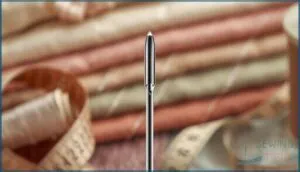
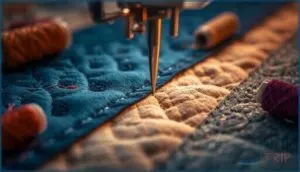
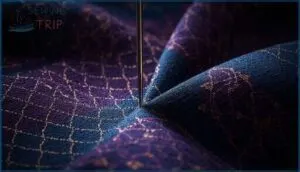
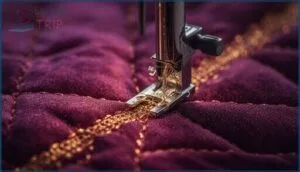
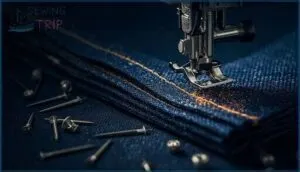
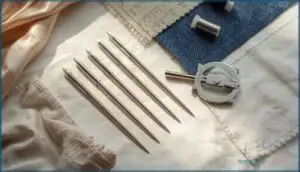
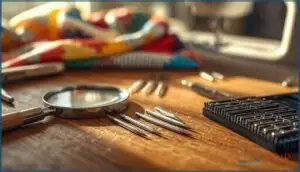
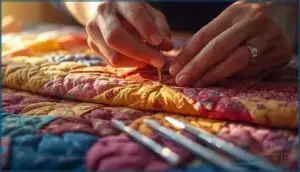
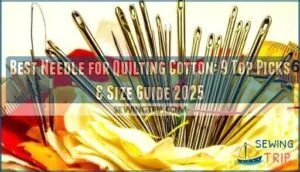
![Different Sewing Machine Needles for Fabrics: The Complete Guide [2025] 7 different sewing machine needles for fabrics](https://sewingtrip.com/wp-content/uploads/2025/03/different-sewing-machine-needles-for-fabrics-300x300.jpeg.webp)
